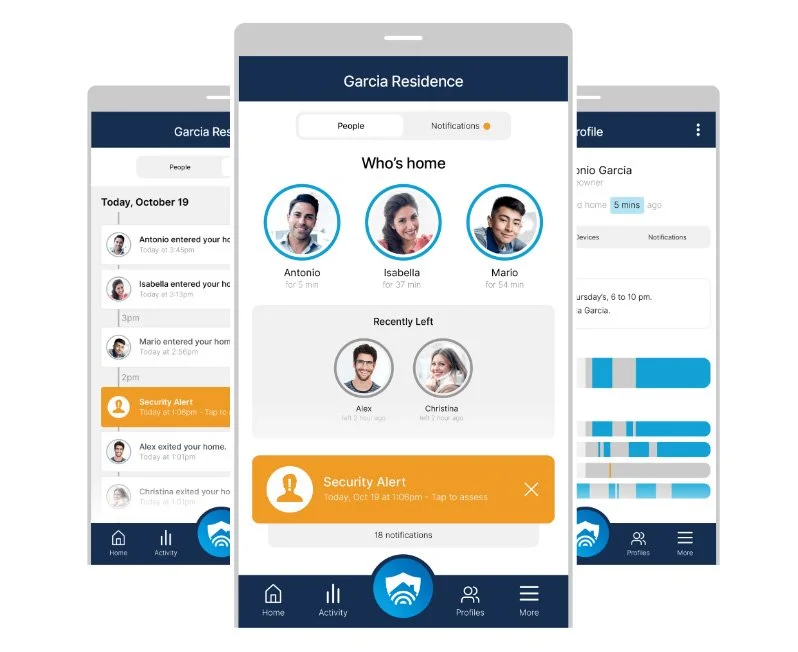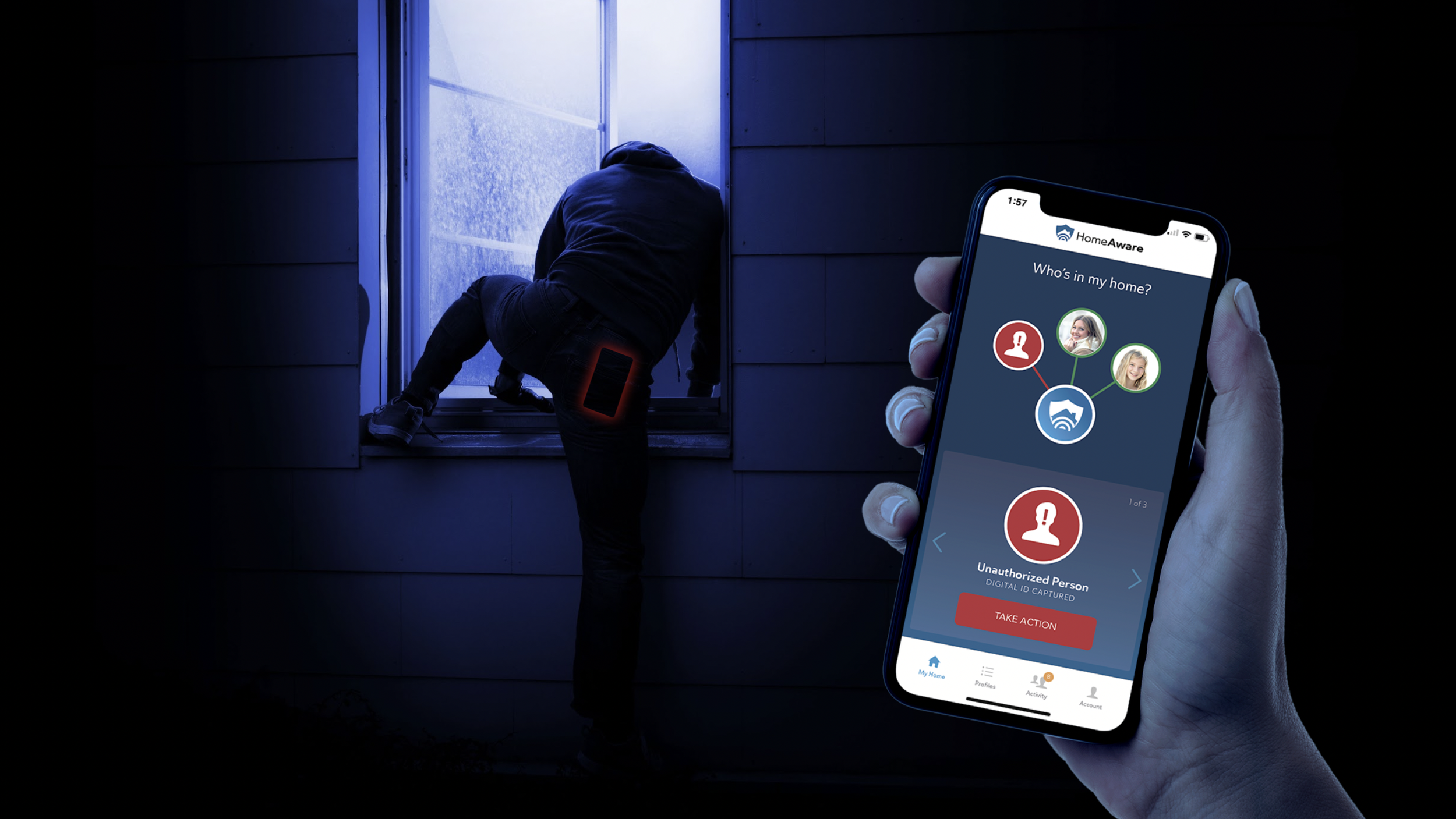Case Study: Turning Doubts into Trust—How HomeAware Mastered Privacy Concerns
READ TIME: 6 MINUTES
In the residential security market, privacy concerns can often challenge new technology. HomeAware, an innovative home awareness solution by Ubiety Technologies, faced this issue. This case study will illustrate how we addressed these concerns and transformed them into a driving force, not a setback.
As home video surveillance becomes ubiquitous, HomeAware offers another approach to address privacy.
Imagine having real-time updates about your home at your fingertips—knowing who’s in your house or when your kids return from school. HomeAware makes it possible. It’s a game-changing solution that uses digital devices to keep you in the loop about the presence of people in your home, giving you peace of mind.
What is HomeAware?
HomeAware is a groundbreaking home awareness solution built by Ubiety Technologies. The first of its kind, it enables homeowners to monitor and identify the presence of people within the home utilizing digital devices like smartphones, smartwatches, tablets, etc.
This improved contextual insight into the occupancy within a home, termed “situational awareness,” empowers homeowners with real-time answers to critical situational questions from the palm of their hand. Questions like: Have the children returned home from school safely? Who’s presently at my home? What time did the housekeeper depart? Is the alarm warning legitimate or a false alarm? In doing so, HomeAware transforms peace of mind from a mere wish into a daily achievable reality.
The Challenges
Despite the promising premise of HomeAware, it had to overcome a common hurdle. Like many home products, privacy concerns were a significant barrier to acceptance. Using personal devices to monitor home occupancy sparked justified fears about surveillance. This resulted in a wall of mistrust that HomeAware needed to dismantle.
Ironically, these concerns persisted despite the widespread acceptance of traditional home security systems that employ video surveillance. Addressing these privacy concerns was crucial for HomeAware to gain broad market appeal.
How We Helped
Contrary to these concerns, HomeAware was built from the ground up with a firm commitment to user privacy. To bridge the gap in perception versus reality, we built a strategy that made privacy central to the product, brand strategy, marketing, and all communications.
Establishing Trust Through Transparency: Building trust was essential. So we set about establishing transparency as a core pillar of the brand to ensure that what we do, how we do it, and how we put the customer in control was clearly explained across touchpoints.
Building Privacy into the Solution: Awareness without control is just noise. That’s why we ensured HomeAware prioritized feature development that gave users command over notifications, home, and profile data.
Showcasing “Situational Awareness” Value: Leveraging situational storytelling, we visually conveyed the value of HomeAware, showing potential users how our solution could resolve real-life challenges while preserving their privacy.
Educating the Customer & Market: We used various resources, from interactive webinars to user-friendly onboarding materials, to help users understand our commitment to privacy.
Embedding Privacy in the Identity: Privacy isn’t just a part of our product—it’s in our DNA. Our “privacy-first” principle, team profiles, and brand narratives clarified this.
Establishing Trust Through Transparency
Trust is earned, not given. For HomeAware, transparency had to be more than an abstract promise—it had to be embedded throughout all operations and interactions. We made privacy a standout feature in HomeAware’s marketing and communication efforts. We set up a dedicated section on the HomeAware website to explain our privacy and data collection methods. All the critical information was made easy to find and communicated using everyday language rather than legal terms.
Privacy-First Communication: We underscored privacy as a prominent feature in all HomeAware’s marketing and communication efforts, championing a privacy-first approach consistently across our messages.
Dedicated Privacy Content: We instituted a designated section on the HomeAware website to clarify our privacy and data collection practices. Here, we made it clear how we offer a less invasive solution compared to traditional systems.
Simple Language: Compliance with US and EU data storage rules was strictly adhered to. Importantly, we used everyday language, not legal jargon, to help users understand these vital details. This information was easily accessible—online, in our mobile app, website, and embedded within the product onboarding process.
Addressing Privacy In-Product: We directly tackled privacy within product interfaces and carried our commitment through to our brand messaging on product packaging and setup procedures. This consistent focus on privacy reinforced trust at every user touchpoint.
HomeAware leveraged complete transparency to build consumer trust.
2. Building Privacy into the Solution
Our strategy extended beyond marketing and communication components. Since the mobile app would be the most engaged touchpoint, privacy was built into the product. We added features that put users in control and designed advanced tools for users to manage their data effectively. We incorporated high-level security mechanisms to reinforce the protective layer around users’ data.
Privacy Features: Considering user control, we implemented options allowing users to turn off or limit the sharing of certain types of information, further augmenting user sovereignty over their data.
Data Management Tools: Advanced toolsets were introduced for users to manage their data effectively. This initiative reinforced our commitment to privacy, empowering users to handle their data confidently.
Security Elements: Recognizing that reassurance comes with security, we embedded high-level security mechanisms into HomeAware. This added a robust protective layer around users’ data, amplifying the safety of their information.
Notifications Management: To respect user preferences, we built robust tools to personalize notifications. This catered to individual needs and underlined our dedication to a user-centric approach.
3. Showcasing “Situational Awareness” Value
Creative storytelling was used to demonstrate the tangible benefits of having real-time situational awareness. We crafted narratives portraying security-focused scenarios and awareness situations effectively handled by HomeAware, showing potential users how our solution could resolve real-life challenges while preserving their privacy.
Security-Centric Storytelling: Our stories captured real-time, security-focused scenarios deftly handled by HomeAware, offering users a vivid insight into the benefits of presence-based insights in relatable, real-world security situations.
Awareness-Centric Storytelling: Moreover, we crafted use cases centered around everyday awareness situations, showcasing how HomeAware delivers meaningful and context-rich information about individuals’ presence—all while diligently maintaining privacy.
Everyday Situations
Security Situations
4. Educating the Customer & Market
Given the complex nature of HomeAware’s technology, we used various resources to help users understand our commitment to privacy. This included hosting interactive webinars, establishing a “how it works” pillar webpage, creating aids like documentation and videos, and designing an informative onboarding process.
Interactive Webinars: We hosted educational webinars, offering a comprehensive overview of HomeAware’s privacy-centric features, elucidating the nuances of our product, and fostering a sense of trust within our audience.
“How it Works” Resources: We designed a variety of aids, including a website “Privacy” pillar content page, user guides, and instructional videos, to enhance user understanding of the technology and foster comfort with its use.
Onboarding Workflows: A straightforward yet informative onboarding process was meticulously crafted, providing a step-by-step walkthrough of HomeAware’s features and privacy measures and instilling confidence in new users right from the get-go.
HomeAware articulated what data is collected, why, and how it is collected.
5. Embedding Privacy in the Identity
Ubiety believes that respecting privacy isn’t just a smart business decision—it’s a reflection of our core values. By embedding privacy within the very identity of our company, we sought to demonstrate that commitment to privacy protection and trust-building.
Highlighting the Privacy-First Principle in Action: We brought attention to the decisive step taken by the founder — onboarding legal experts from the start. This stressed how the ‘privacy-first’ principle was not just a mantra but a guideline that shaped every aspect of HomeAware’s operations, ensuring the highest privacy standards were always met.
Team Profiles with a Privacy Focus: Our leadership team’s profiles were curated to illuminate their personal commitments to privacy, going beyond the corporate responsibility to express our collective dedication to upholding user privacy.
Crafting Privacy-Centric Narratives: We shaped the narratives around our brand and our founder to underscore privacy’s central role in our product development. We ensured these stories exemplified how privacy is not just an element but the essence of our solution’s creation and evolution.
The Results
Our efforts bore fruit, as evidenced by the significant improvement in various key performance indicators:
Beta Program Enrollments: We witnessed a substantial increase in our beta program signups, a 29% uplift. This trend showcased our product's growing interest and acceptance among potential users.
Lead Generation: Our tailored approach towards communication and privacy emphasis is reflected in the surge of lead signups by 67%. This development points to an escalating trust in our brand and its values.
Website User Engagement: We recorded a dramatic decrease in website page bounce rate by 52%. This achievement underscores the efficacy of our educational resources and transparency initiatives in keeping visitors engaged.
Social Sentiments: Negative social engagements, a measure of public sentiment, saw a significant dip of 31%. This decline indicates our efforts' success in mitigating privacy concerns and building consumer trust.
A Promising Horizon
Despite being in beta, we've made significant strides in addressing privacy concerns, clearing the path for adoption. Our proactive privacy approach, feature integration, and user education efforts have fostered trust among prospective users. Early successes, like increased beta sign-ups and reduced bounce rates, affirm the effectiveness of our privacy-first messaging and transparency initiatives.
We look forward to seeing the future success of HomeAware.









